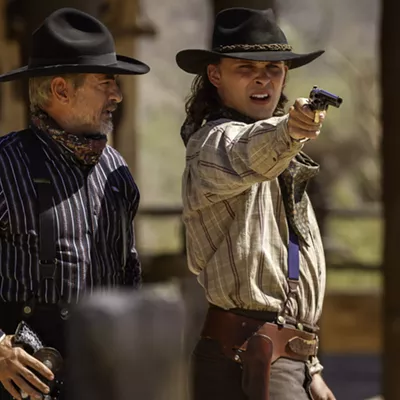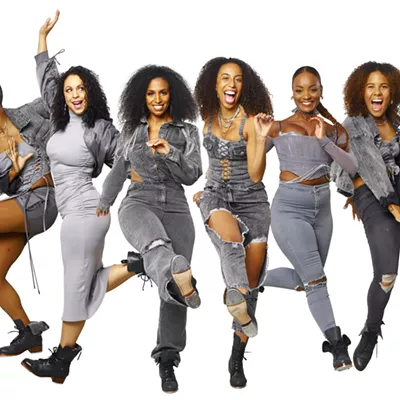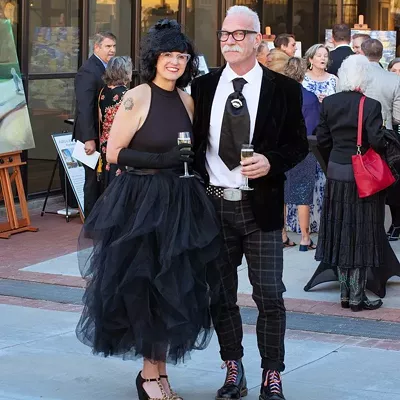In these desperate hot days, as we await the monsoons, art offers us a refuge. Take a look at these museums and galleries, guaranteed to have air conditioning. These aren’t your only options, though. MOCA has a great show by Grace Rosario Perkins, and Tohono Chul’s “The Elements-Air” offers up the work of 41 Arizona artists.
Enjoy!
Tucson Museum of Art
On a night in 1956, Brad Kahlhamer arrived on the 11:59 to Tucson. And as curator Julie Sasse, says in an essay about the artist, “Metaphorically, Kahlhamer is waiting for the ‘11:59 to Tucson’ to take him back to his beginnings.”
The renowned artist-musician was born in Tucson that night, but he’s never learned who his birth parents were. Adopted by a kindly white couple, he was told only that one or both of his parents were Native. The mystery of his identity has been with him ever since, and it is crucial to his art.
A major exhibition at the Tucson Museum of Art is filled with his color paintings and wild images of Western animals, mountains, Native peoples as well as self-portraits. “Buffalo, Headlands” is a marvelous example of what the museum calls his “signature visual language:” paint everywhere, thick and thin, splashed and battered.
Some of his work is about his own life. The oil canvas “To Be Titled,” for instance, shows himself in long black hair and darkish skin. Elsewhere, a picture of a Native man bears the letters UGH, a memory of school-days bullying. The kids called a Native man that racist name, and soon began harassing Kahlhamer with the same epithet. Eventually, Kahlhamer honored the man by proudly calling himself UGH Jr. 224
Much of the work incorporates symbols and motifs that are associated with Native cultures in the West. The bright orange and black painting “Dakota” is a vision of abstract shapes that could be animals or people. “American Horse” is an acrylic work that features tiny little horses circling around the perimeter of a massive human face. A controversial series, “Next Level Figures,” is inspired by Hopi kachinas, 3D constructions of wood and wire, feathers and braided rope, and painted images.
After college in Wisconsin, Kahlhamer made his way to the East Village in New York City, where he found a circle of artists and musicians who would become lifelong friends. His work, “Fort Gotham Girls and Boys Club,” in acrylic and ink celebrates these friendships, while also making images in the style of Northwestern Native cultures. But he has not forgotten Tucson. In one of the many sketchbooks in the show, he drew a loose picture of the saguaros and mountains of Marana. And in that picture, he drew himself as a little boy playing in the desert he hasn’t forgotten.
Brad Kahlhammer’s “11:59 to Tucson:” runs through Sunday, Sept. 25 at Tucson Museum of Art. Hours: 10 a.m. to 5 p.m. Thursday to Sunday.
tucsonmuseumofart.com; 520-623-2333
Sculpture Tucson
Sculpture Tucson is trying blacksmith-made metal hooks on for size.
This something new and different for the organization, which regularly puts up good-size sculptures outside around the city, to everyone’s delight.
This time around the group will display work that’s small, but comes in abundance. The show has no fewer than 366 hooks, all made by Matt Jenkins, a Canadian blacksmith who has won multiple prizes along with internationals acclaim. The hooks are sort of like household handles, but Jenkins’s are pieces of art.
In 2016, he began on the work “#366Hooks: Form and Designed Revealed Over a Year’s Time.” The plan was to fire up his smithy and produce a one unique hook every single day of the year. He succeeded in spades, even making an extra hook for leap year 2016.
The handsome pieces, come in all shapes and (smallish) sizes.
Barbara Grygutis, a well-known sculpture artist and a founder of Sculpture Tucson, says that “#366Hooks is an opportunity for art enthusiasts to re-examine their relationship with everyday objects and encourages us all to think outside the ‘hook’ when it comes to functional design.”
The art is on view in the Sculpture Tucson’s Post House in Brandi Fenton Memorial Park on River Road. The exhibition is free and open to the public; it runs 9 a.m. to 1 p.m. Tuesday to Saturday. The show runs through Monday, Aug. 15.
Contreras Gallery
In the art warehouse district, the summer “Tucson” show at Contreras Gallery is always a hit. The rules, written by owners Neda and Michael Contreras, are simple. Artists can portray “Tucson and anything that relates to it: its people, culture architecture, landscapes, plants, fauna and insects etc.
This year, nine artists painted our favorite city and environs. The usual cacti, flowers and blue ski are in abundance, but where’s a strong showing of architecture, both historical and grungy.
Richard Engesser followed the latter, He painted an old man lounging against the walls of The Buffet Bar. Interestingly, Engesser painted the dive’s pavement clean and the walls nicely painted. Another work, “Quonset Hut on Dodge,” takes a look at a poorer side of town.
Other favorites are Jack Petty’s “Ash Ally,” a pretty hangout for cool artists in the ’50s, and Jacqueline Chanda’s “Coffee Shop at the Courthouse.” Good for her for picturing workers on an ordinary day, instead painting grand the Courthouse dome. And finally, I am taken by Gene Hall’s painted birds and bugs.
“Tucson” runs to Friday, Aug. 26, at Contreras Gallery, 110 E. Sixth Street, Monday to Friday, 10 a.m. to 3 p.m. Masks required. contrerashousefineart.com; 520-398-6557











